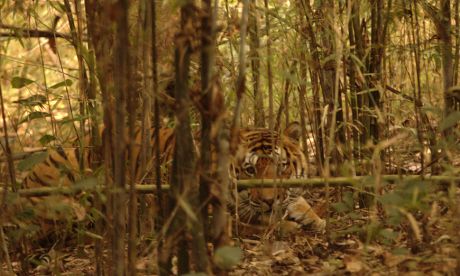
Tiger, tiger burning bright? Sadly not, but there’s still a fair chance you’ll spot one in our pick of India’s 10 best tiger reserves
First glance: Rajasthan’s premier wildlife reserve is famed for its tigers, scenery and history: rolling hills, dry dhok forest and tranquil lakes, crumbling ruins of Mughal temples and a tenth-century hilltop fort.
Chance of sighting: Tiger numbers – once around 40 – have tumbled due to poaching, but you still stand a fairly good chance of spotting the big cat. Just remember, this is a popular park where the jeeps run wild...
Other wildlife: Keep your eyes peeled for leopard, sloth bear and dhole (wild dog). Common species such as rhesus macaque, wild boar, sambar and chital are almost guaranteed, and the birdlife is sensational (parakeets and peacocks galore).
Safaris by: Jeep
First glance: A 625 sq km reserve of mainly teak and bamboo forest.
Chance of sighting: Good. You’ll see few other tourists and up to 40 tigers are estimated to live here.
Other wildlife: Leopard, sloth bear, gaur, dhole, plus a few surprises such as striped hyena and jungle cat.
On safari: Jeep
First glance: Inspiration for Kipling’s The Jungle Book; Pench covers 758 sq km of prime tiger country. The Pench River (a series of pools during the dry season) meanders through hills cloaked in teak forest.
Chance of sighting: The waterholes are probably your best bet for a tiger encounter, although anywhere around the park can be rewarding.
Other wildlife: Gaur, wild boar, spotted and sambar deer and common langur are almost guaranteed. Fingers crossed for leopard.
Safaris by: Jeep
First glance: Named after hunter-turned-conservationist Jim Corbett, this beautiful park is draped over the Himalayan foothills in a rich mosaic of dense forests and wide river plains.
Chance of sighting: They’re out there, somewhere, but the dense vegetation means tiger encounters are hit-and-miss. Follow the alarm calls of birds and monkeys – they’re your spies in the jungle.
Other wildlife: Those aren’t boulders, they’re wild Asian elephant grazing the floodplains. Look out for gharial crocodile, too, plus a full cast of Indian safari wildlife. Corbett’s birding is some of the best in Asia.
Safaris by: Jeep, elephant-back
First glance: Steeped in history, this former royal hunting reserve in the Vindhyan Hills has an ancient fort perched atop an 800m-high plateau.
Chance of sighting: Better than most – Bandhavgarh has one of India’s highest tiger densities.
Other wildlife: Good range of other mammals, including sambar and spotted deer, langur and rhesus macaque, sloth bear, dhole and leopard.
Safari by: Jeep and elephant-back
First glance: World Heritage site extending into Bhutan and encompassing grasslands and forests along the banks of the Manas River in the Himalayan foothills.
Chance of sighting: Thick forest makes sightings difficult, but this is exciting, little-visited territory to explore.
Other wildlife: Endemic golden langur, elephant and exotic birds such as great hornbill and red-headed trogon.
Safaris by: Jeep
First glance: Thick swathes of swamp, elephant grass, reedbed and forest crowd the banks of the Brahmaputra River in this remote wildlife-rich gem.
Chance of sighting: Quite slim – it’s a jungle out there; blink and all you may see is a stripy tail vanishing into the grass.
Other wildlife: 80% of the world’s population of Indian greater one-horned rhinoceros lives here. Large herds of elephant and buffalo are also present, along with sambar, swamp and hog deer. The birdlife is excellent, especially if you’re partial to pelicans.
Safaris by: Jeep, elephant-back
First glance: Lush forests in the Cardamom Hills of the Western Ghats.
Chance of sighting: Slim; most visitors join boat trips, but they can be crowded and noisy.
Other wildlife: Elephant, gaur, wild boar, four species of primate (including the endemic lion-tailed macaque), sloth bear, leopard and otter. Fabulous butterfly and birdlife.
Safaris by: Jeep, boat trips on Lake Periyar
First glance: Spread over 10,000 sq km of the Ganges Delta, the Sunderbans is a gloriously muddy mishmash of tidal waterways, mudflats and mangrove forest.
Chance of sighting: A stronghold for the Bengal tiger, but the swampy nature of the place makes them hard to spot. Seek advice from local honey collectors, but be warned that Sunderbans’ tigers are occasional man-eaters!
Other wildlife: Crocodiles, snakes, spotted deer, waterbirds.
Safaris by: Boat tour, ferry
First glance: Covering an area of 1,945 sq km, Kanha’s habitats range from bamboo and sal forest to grassland and rugged plateau.
Chance of sighting: Stake out grassland areas for a chance to see tigers hunting.
Other wildlife: The park is renowned for its swamp deer, but you’ll also find spotted, sambar and barking deer, plus four varieties of antelope. 220 bird species include forest beauties such as the Malabar pied hornbill.
Safaris by: Jeep and elephant-back